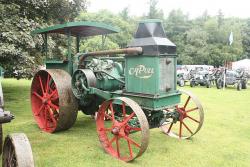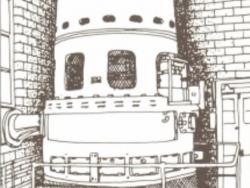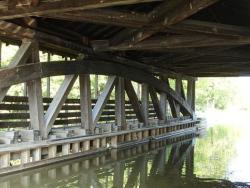Duck Creek Aqueduct is a rare surviving example of a covered timber aqueduct. It was one of several similar structures on the Whitewater Canal, which operated between the Whitewater Valley and the Ohio River from 1839 to 1865. After being displaced by the railroad, the canal supplied hydraulic power for the industrial districts at Metamora and Brookville.
IN

The Universal Soil Loss Equation (USLE) was developed at the USDA National Runoff and Soil Loss Data Center at Purdue University in a national effort led by Walter H. Wischmeier and Dwight D. Smith. The USLE was published in 1965 in USDA Agriculture Handbook 282.
A = average annual soil loss (in tons/acre)
R = rainfall erosivity index
K = soil erodibility factor
LS = topographic factor
C = cropping factor
P = conservation practice factor

On June 30, 1857, James Oliver filed a patent application for chilling the wear face of cast-iron moldboard plows. While pouring molten cast iron in sand molds he circulated hot water through chillers to regulate the rate of cooling. Oliver's control of raw material content and cooling produced moldboards with a very hard surface and a softer, tough inner core for strength. Their fine textured wearing faces of uniform hardness maintained a mirror polish and resisted rust.

The Rumely Companies, which operated in La Porte, Indiana, from 1853 to 1931, produced a variety of equipment including threshers and steam engines, which helped to change the nature of American and world agriculture. The revolutionary OilPull Tractor, which was introduced in 1910, used a unique carburetion system developed by John Secor, the Company's Chief Engineer. The OilPull tractor efficiently converted a low cost petroleum product to mechanical power, greatly reducing the need for animal and steam power on American farms. Dr.
The Purdue University Airport was the first collegiate owned airport in the United States. It hosted Amelia Earhart for her final adventure, was the training ground for test pilots such a Jimmy Johnson and Ivan Kincheloe, balloonist Malcolm Ross, and astronaut Neil Armstrong. Purdue University Airport and its people and programs pushed aviation’s evolution to new heights and helped expand the frontiers of flight. During WWII, hundreds of U.S. Army and Navy members were trained at the airport.

The steel dome stretches 200 feet in diameter and rises 100 feet at its top. To accommodate thermal expansion, the inverted bowl-shaped structure originally rested on rollers that sat on the flat tops of six-story columns
There was a time when Americans from the Eastern seaboard braved long rail trips to southern Indiana in hopes that the water at the French Lick natural mineral springs could bring relief from alcoholism, pimples, gallstones and a host of other ailments and illnesses.

Beginning with the blacksmith shop of German immigrant Meinrad Rumely (1823-1904), this successive family of firms invented and produced a line of agricultural equipment that played a vital role in the evolution of farming based on the muscle of humans and animals to one based on the power of the steam and ultimately the internal-combustion engine. The M. & J. Rumely Co. became the M. Rumely Co., and then the Advance Rumely Co. The Allis-Chalmers Company acquired the business in 1931.

The significance of the 15-mile Whitewater Canal was not in its ability to create a profit, but rather its effect on the economic growth of the Whitewater River Valley, considered the gateway to the interior of Indiana. Before the canal, travel was challenging. Most waterways in Indiana were only navigable by canoe, and the alternative - horse and wagon - was difficult, slow and expensive.

It is difficult to recall a time when doctors and patients had trouble tracking the presence of glucose and other substances in urine and blood. Lack of sufficient measurement tools made it difficult to manage a host of diseases, including diabetes as well as other metabolic diseases and kidney and liver conditions. Today, self-management of these diseases is an easier process because of the development of diagnostic test strips by Alfred and Helen Free and their research team at Miles Laboratories.
The text of the plaque commemorating the development reads:

This, the first Curtis vertical turbine built, was constructed by the General Electric Co. for the Newport & Fall River Street Railway Co. It operated in the Newport, R.I., generating station until June 1927. It was transferred to the Harding Street Station of the Indianapolis Power & Light Co. for display and later moved to the company's E.W. Stout Station.
Innovations

This, the first Curtis vertical turbine built, was constructed by the General Electric Co. for the Newport & Fall River Street Railway Co. It operated in the Newport, R.I., generating station until June 1927. It was transferred to the Harding Street Station of the Indianapolis Power &…
Read More
It is difficult to recall a time when doctors and patients had trouble tracking the presence of glucose and other substances in urine and blood. Lack of sufficient measurement tools made it difficult to manage a host of diseases, including diabetes as well as other metabolic diseases and kidney…
Read More
The significance of the 15-mile Whitewater Canal was not in its ability to create a profit, but rather its effect on the economic growth of the Whitewater River Valley, considered the gateway to the interior of Indiana. Before the canal, travel was challenging. Most waterways in Indiana…

Beginning with the blacksmith shop of German immigrant Meinrad Rumely (1823-1904), this successive family of firms invented and produced a line of agricultural equipment that played a vital role in the evolution of farming based on the muscle of humans and animals to one based on the power of…
Read More
The steel dome stretches 200 feet in diameter and rises 100 feet at its top. To accommodate thermal expansion, the inverted bowl-shaped structure originally rested on rollers that sat on the flat tops of six-story columns
There was a time when Americans from the Eastern seaboard braved…
Read MoreThe Purdue University Airport was the first collegiate owned airport in the United States. It hosted Amelia Earhart for her final adventure, was the training ground for test pilots such a Jimmy Johnson and Ivan Kincheloe, balloonist Malcolm Ross, and astronaut Neil Armstrong.…
Read More
The Rumely Companies, which operated in La Porte, Indiana, from 1853 to 1931, produced a variety of equipment including threshers and steam engines, which helped to change the nature of American and world agriculture. The revolutionary OilPull Tractor, which was introduced in 1910,…
Read More
On June 30, 1857, James Oliver filed a patent application for chilling the wear face of cast-iron moldboard plows. While pouring molten cast iron in sand molds he circulated hot water through chillers to regulate the rate of cooling. Oliver's control of raw material content and…
Read More
The Universal Soil Loss Equation (USLE) was developed at the USDA National Runoff and Soil Loss Data Center at Purdue University in a national effort led by Walter H. Wischmeier and Dwight D. Smith. The USLE was published in 1965 in USDA Agriculture Handbook 282.
The USLE is…
Read MoreDuck Creek Aqueduct is a rare surviving example of a covered timber aqueduct. It was one of several similar structures on the Whitewater Canal, which operated between the Whitewater Valley and the Ohio River from 1839 to 1865. After being displaced by the railroad, the canal supplied hydraulic…
Read More

